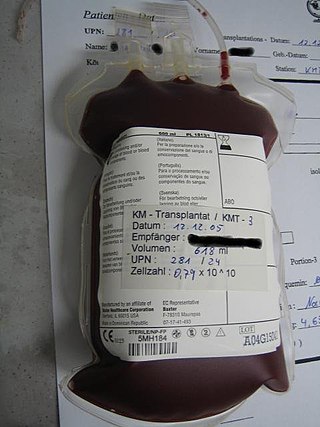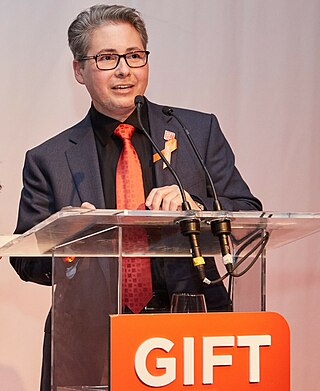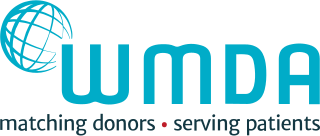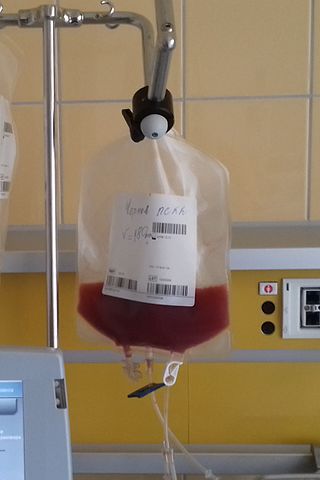
Leukemia is a group of blood cancers that usually begin in the bone marrow and result in high numbers of abnormal blood cells. These blood cells are not fully developed and are called blasts or leukemia cells. Symptoms may include bleeding and bruising, bone pain, fatigue, fever, and an increased risk of infections. These symptoms occur due to a lack of normal blood cells. Diagnosis is typically made by blood tests or bone marrow biopsy.
Aplastic anemia (AA) is a severe hematologic condition in which the body fails to make blood cells in sufficient numbers. Aplastic anemia is associated with cancer and various cancer syndromes. Blood cells are produced in the bone marrow by stem cells that reside there. Aplastic anemia causes a deficiency of all blood cell types: red blood cells, white blood cells, and platelets.

Bone marrow is a semi-solid tissue found within the spongy portions of bones. In birds and mammals, bone marrow is the primary site of new blood cell production. It is composed of hematopoietic cells, marrow adipose tissue, and supportive stromal cells. In adult humans, bone marrow is primarily located in the ribs, vertebrae, sternum, and bones of the pelvis. Bone marrow comprises approximately 5% of total body mass in healthy adult humans, such that a man weighing 73 kg (161 lbs) will have around 3.7 kg (8 lbs) of bone marrow.

Hematopoietic stem-cell transplantation (HSCT) is the transplantation of multipotent hematopoietic stem cells, usually derived from bone marrow, peripheral blood, or umbilical cord blood, in order to replicate inside a patient and produce additional normal blood cells. HSCT may be autologous, syngeneic, or allogeneic.
A cord blood bank is a facility which stores umbilical cord blood for future use. Both private and public cord blood banks have developed in response to the potential for cord blood in treating diseases of the blood and immune systems. Public cord blood banks accept donations to be used for anyone in need, and as such function like public blood banks. Traditionally, public cord blood banking has been more widely accepted by the medical community. Private cord blood banks store cord blood solely for potential use by the donor or donor's family. Private banks typically charge around $2,000 for the collection and around $200 a year for storage.

Anthony Nolan is a UK charity that works in the areas of leukaemia and hematopoietic stem cell transplantation. It manages and recruits donors to the Anthony Nolan Register, which is part of an aligned registry that also includes the Welsh Bone Marrow Donor Registry, NHS Blood and Transplant's British Bone Marrow Registry and Deutsche KnochenMarkSpenderdatei (DKMS) UK. This aligned register is known as the Anthony Nolan & NHS Stem Cell Registry. It also carries out research to help make bone marrow transplants more effective.

Cell therapy is a therapy in which viable cells are injected, grafted or implanted into a patient in order to effectuate a medicinal effect, for example, by transplanting T-cells capable of fighting cancer cells via cell-mediated immunity in the course of immunotherapy, or grafting stem cells to regenerate diseased tissues.

Jay Feinberg is a long-term leukemia survivor, community organizer and founder and current CEO of the Gift of Life Marrow Registry.
The National Marrow Donor Program (NMDP) is a nonprofit organization founded in 1987 and based in Minneapolis, Minnesota, that operates the Be The Match Registry of volunteer hematopoietic cell donors and umbilical cord blood units in the United States.

World Marrow Donor Association (WMDA) is an organization based in Leiden, Netherlands, that coordinates the collection of the HLA phenotypes and other relevant data of volunteer hematopoietic cell donors and cord blood units across the globe.
Juvenile myelomonocytic leukemia (JMML) is a rare form of chronic leukemia that affects children, commonly those aged four and younger. The name JMML now encompasses all diagnoses formerly referred to as juvenile chronic myeloid leukemia (JCML), chronic myelomonocytic leukemia of infancy, and infantile monosomy 7 syndrome. The average age of patients at diagnosis is two (2) years old. The World Health Organization has included JMML as a subcategory of myelodysplastic and myeloproliferative disorders.
Donor lymphocyte infusion (DLI) or buffy coat infusion is a form of adoptive immunotherapy used after hematopoietic stem cell transplantation.

Peripheral blood stem cell transplantation (PBSCT), also called "Peripheral stem cell support", is a method of replacing blood-forming stem cells. Stem cells can be destroyed through cancer treatments such as chemotherapy or radiation, as well as any blood-related diseases, such as leukemia, lymphoma, neuroblastoma and multiple myeloma. PBSCT is now a much more common procedure than its bone marrow harvest equivalent due to the ease and less invasive nature of the procedure. Studies suggest that PBSCT has a better outcome in terms of the number of hematopoietic stem cell yield.

Childhood leukemia is leukemia that occurs in a child and is a type of childhood cancer. Childhood leukemia is the most common childhood cancer, accounting for 29% of cancers in children aged 0–14 in 2018. There are multiple forms of leukemia that occur in children, the most common being acute lymphoblastic leukemia (ALL) followed by acute myeloid leukemia (AML). Survival rates vary depending on the type of leukemia, but may be as high as 90% in ALL.
Microtransplantation (MST) is an advanced technology to treat malignant hematological diseases and tumors by infusing patients with granulocyte colony-stimulating factor (G-CSF) mobilized human leukocyte antigen (HLA)-mismatched allogeneic peripheral blood stem cells following a reduced-intensity chemotherapy or targeted therapy. The term "microtransplantation" comes from its mechanism of reaching donor cell microchimerism.
Deutsche Knochenmarkspenderdatei, abbreviated as DKMS, is an international nonprofit bone marrow donor center based in Tübingen, Germany, with entities in Chile, India, Poland, South Africa, the United Kingdom and the United States. DKMS works in the areas of blood cancer and hematopoietic stem cell transplantation and raises awareness of the need for donors for hematopoietic stem cell transplantation which people with blood cancers need for treatment as well as helping people sign up to their national bone marrow registries. Over the years, DKMS has expanded beyond Germany.
Amal Bishara is an Israeli Arab doctor, and the director of Bone Marrow Registry Outreach, Hadassah Medical Center, which is associated with the Hebrew University of Jerusalem in Israel. There she runs the only bone marrow transplant registry in the world for unrelated Arab donors. Dr. Amal has published and presented internationally on her research into immunogenetics. She serves on the Accreditation Committee of the European Federation for Immunogenetics.

DATRI is a not-for-profit organization registered in 2009 as a Section 8 company under Government of India. DATRI is one of the largest unrelated blood stem cell donors registry in India, that helps patients with blood cancer and other fatal blood disorders to find a HLA matched Blood Stem Cell donor. Blood stem cell transplant is a chance of cure for patients with blood cancer and other severe blood disorders. As of January 2023, DATRI has more than 5 lakhs voluntary donors registered and it has facilitated 1074 plus transplants worldwide. DATRI operates across India.

Shimon Slavin is an Israeli professor of medicine. Slavin pioneered the use of immunotherapy mediated by allogeneic donor lymphocytes and innovative methods for stem cell transplantation for the cure of hematological malignancies and solid tumors, and using hematopoietic stem cells for induction of transplantation tolerance to bone marrow and donor allografts.
African Caribbean Leukaemia Trust (ACLT) is an independent UK charity for people with leukaemia and other life-threatening disorders. The ACLT aims to raise awareness on stem cell, blood and organ donation in the UK, with a particular focus on black and mixed race communities.











